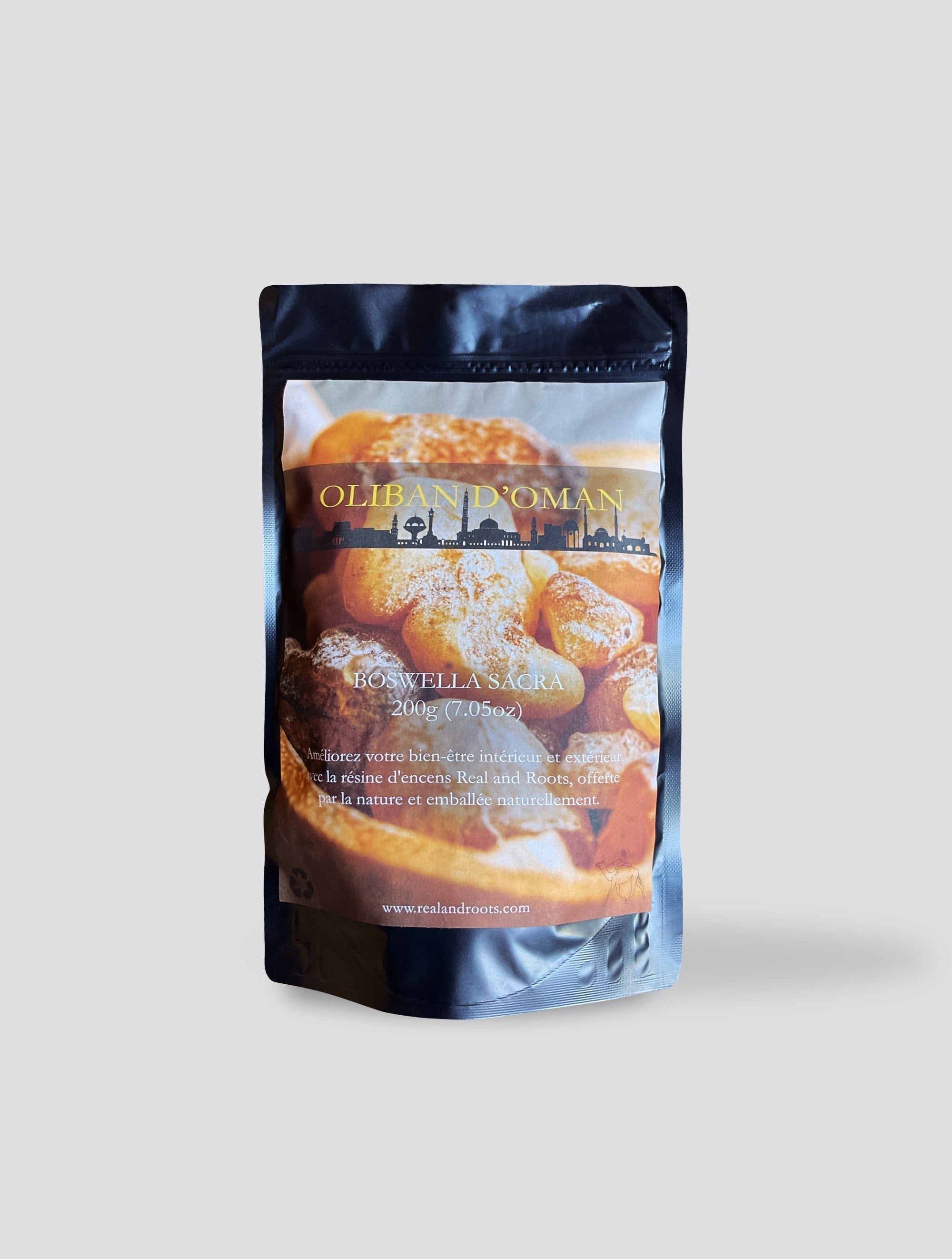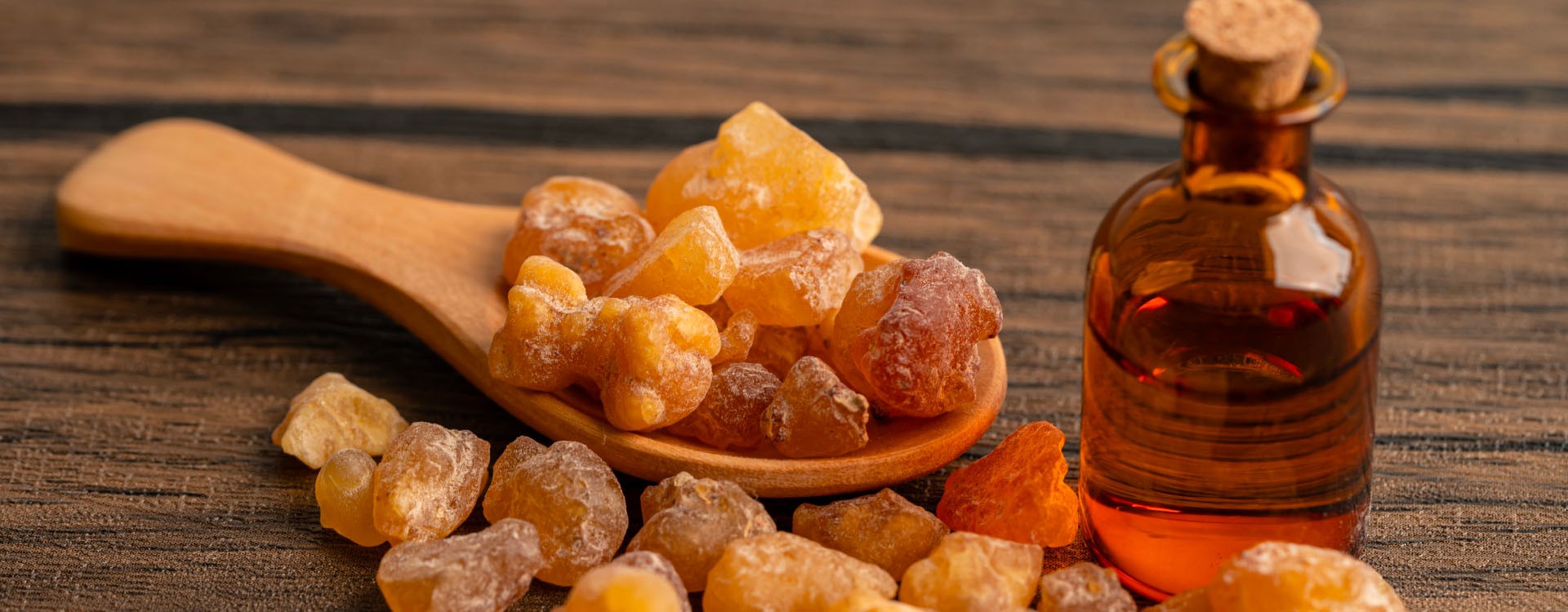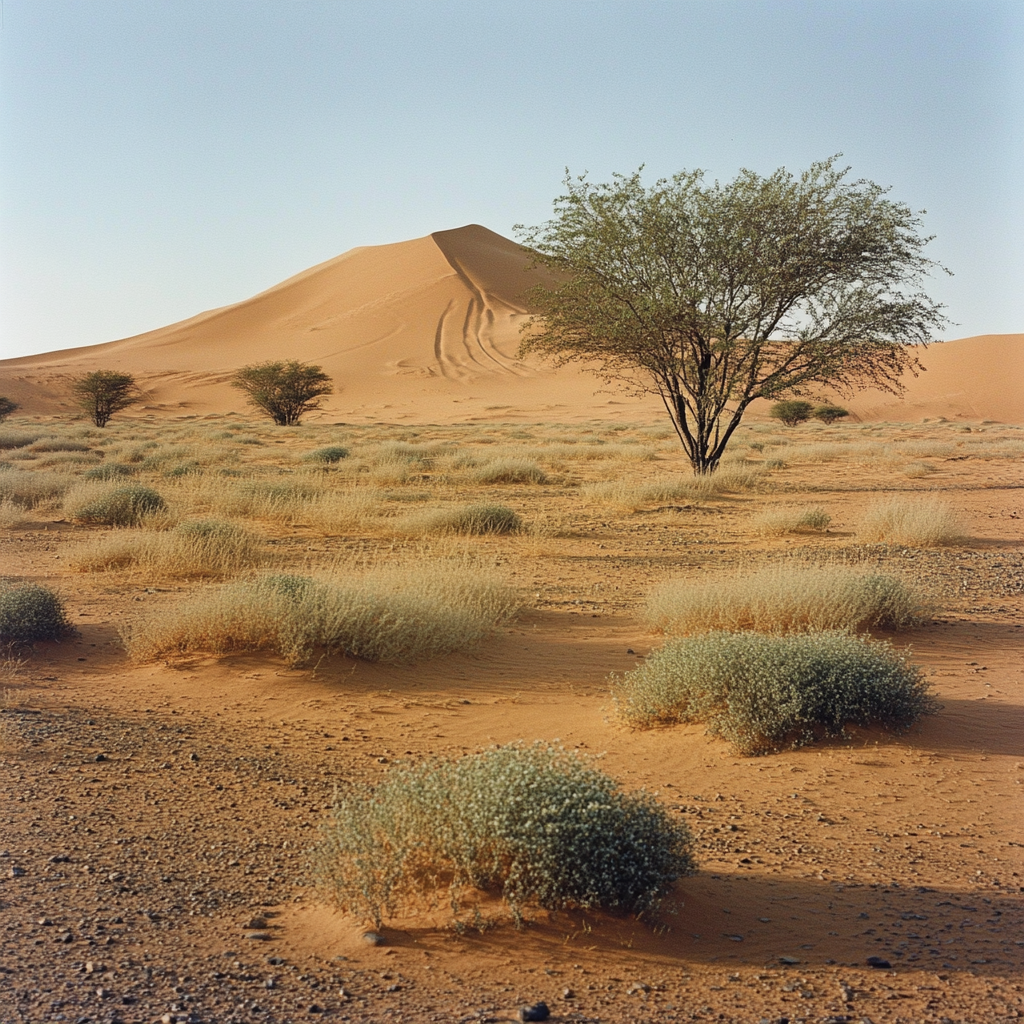Frankincense: An exploration of its origins, properties and applications

Frankincense: A complete exploration of its origins, properties and applications
Frankincense, an aromatic resin extracted from trees of the Boswellia genus, occupies a unique place in human history, combining spirituality, traditional medicine and modern applications. Its anti-inflammatory, antimicrobial and anxiolytic properties, confirmed by scientific studies, make it a subject of interest in contemporary pharmacology. Originating in the arid regions of the Arabian Peninsula, this resin has crossed the centuries via legendary trade routes, while retaining its status as a sacred symbol in several religions. Our succinct blog examines its botany, history, chemical composition, therapeutic uses and current applications, revealing why we at Real and Roots regard frankincense as a resource as valuable as it is versatile.
1. Botany and origin of frankincense
The Boswellia genus, belonging to the Burseraceae family, includes several olibanum-producing species, including Boswellia sacra (Oman, Yemen), Boswellia serrata (India) and Boswellia rivae (Horn of Africa). These trees, reaching heights of 5 to 7 meters, are characterized by their ability to thrive in hostile environments, such as the rocky high plateaus of Oman's Dhofar region. Their resistance to drought and nutrient-poor soils explains their limited geographical distribution, mainly concentrated around the Red Sea and Gulf of Aden.
Species differentiation
Species differentiation is based on morphological and chemical criteria. For example, Boswellia sacra produces a more lactescent resin rich in boswellic acids than Boswellia serrata, whose compounds are studied more for their anti-arthritic effects. These variations influence not only traditional uses, but also modern pharmacological applications.
2. Harvesting and production
The harvesting of frankincense follows a meticulous process handed down from ancient times. Gatherers make shallow incisions in the bark of male trees at least ten years old, allowing the milky sap to flow out and solidify on contact with the air. This hardened resin, known as "tears", is collected two to three weeks later, with higher quality for autumn harvests ("white incense") than for spring harvests ("red incense").
Although methods remain largely manual, recent innovations aim to optimize yield without compromising ecological sustainability. For example, cooperatives in Oman are experimenting with ceramic tools to reduce metal contamination during incision. Despite these advances, annual world production stagnates at around 2,000 tonnes, reflecting the challenges of slow tree growth and degradation of natural habitats.
3. History and ancient uses.
As early as the 16th century BC, the Ebers Papyrus mentioned incense as a remedy for asthma and inflammation. The Egyptians included it in embalming rituals and offerings to the gods, while Greek physicians such as Galen prescribed it to fortify the stomach and treat fevers. The Romans, great consumers of frankincense, burned prodigious quantities during imperial ceremonies, contributing to the expansion of the Incense Route linking Arabia to the Mediterranean.
This trade route, traversed by camel caravans, led to the emergence of prosperous cities such as Petra and Palmyra. Incense, then more precious than gold, symbolized both divine power and social status, as witnessed by the offerings of the Three Wise Men in Christian tradition.

4. Spiritual dimension
Frankincense plays a central role in Christian, Islamic and Hindu rites. In Catholic liturgy, its use in incense represents prayers rising up to God, a metaphor taken from Psalm 141.
In Ayurveda, it is associated with energy purification and the treatment of inflammatory diseases.
Sufi cultures see it as a means of facilitating meditation and connection with the divine, thanks to its soothing aroma.
This spiritual dimension persists today, particularly in energy purification practices where frankincense is burned to dispel negative influences. Its fragrance, described as both woody and lemony, acts as an olfactory anchor, encouraging concentration during yoga or prayer sessions.
5. Chemical composition and properties
Olibanum essential oil, obtained by distillation of the resin, contains monoterpenes (α-pinene, β-pinene) and sesquiterpenes, responsible for its deep aromatic notes. However, it's the boswellic acids (pentacyclic triterpenes) that are attracting the most scientific interest. These molecules, like acetyl-11-keto-β-boswellic acid (AKBA), inhibit 5-lipoxygenase, a key enzyme in the synthesis of pro-inflammatory leukotrienes.
In vitro studies have also demonstrated antiproliferative effects on cancer cells, probably via modulation of theNF-κB3 pathway. In addition, δ-3-carene, a monoterpene present in up to 15% of the plant, has proven expectorant properties in the treatment of chronic bronchitis.
6. Modern applications
Pharmacology
The anti-inflammatory properties of frankincense are comparable to those of NSAIDs (non-steroidal anti-inflammatory drugs), but with fewer gastrointestinal side effects. A randomized, double-blind study demonstrated its efficacy in reducing joint pain in osteoarthritis patients, with a 40% reduction in WOMAC scores after 8 weeks of treatment.
Neurologically, α-pinene acts as a modulator of GABA-A receptors, explaining its anxiolytic effect observed in mouse models. These mechanisms complement its antioxidant action, where the resin's phenolic compounds neutralize free radicals, protecting neurons from the oxidative stress associated with neurodegenerative diseases.
Aromatherapy
In aromatherapy, diffusion of olibanum essential oil reduced salivary cortisol levels by 25% according to a controlled study. This reduction in physiological stress is accompanied by an improvement in cognitive parameters such as working memory and mental flexibility, as measured by neuropsychological tests. Practitioners of integrative psychology use it as an adjuvant in therapies for generalized anxiety disorders, often in combination with mindfulness meditation.
In palliative care units, experimental protocols incorporate the olfaction of frankincense to alleviate existential anguish in terminally ill patients. Preliminary reports indicate a significant increase in feelings of inner peace and acceptance.
Cosmetology
The healing properties of frankincense can be applied to the treatment of chronic wounds. A 5% formulation of Boswellia serrata extract accelerates closure of diabetic ulcers by 30% compared to placebo, thanks to stimulation of fibroblasts and inhibition of matrix metalloproteinases.
In cosmetology, olibanum-based creams show comparable efficacy to retinol in reducing periocular wrinkles, without the latter's irritatingeffects3. Its antibacterial action against Cutibacterium acnes also makes it a key ingredient in serums for acne-prone skin.
7. Challenges and the future of frankincense
With annual demand set to grow by 8% from 2020, the frankincense industry faces major logistical and ecological challenges. Over-exploitation of wild boswellia in Somalia and Ethiopia has led to a 50% decline in natural populations over the past decade. In response, fair trade certification programs, such as that run by the NGO FairWild, encourage sustainable harvesting practices and the systematic replanting of trees.
Technologically speaking, plant biotechnologies offer promising alternatives. German researchers have succeeded in producing boswellic acids in vitro using Boswellia sacra cell cultures, although the prohibitive cost of these methods still limits their commercial application.
University hospitals across Europe are beginning to incorporate frankincense into their integrative medicine protocols. For example, the Charité in Berlin offers aromatherapy sessions with frankincense as an adjunct to chemotherapy, aimed at alleviating cisplatin-induced nausea. These approaches, while requiring further clinical validation, reflect a growing recognition of traditional medicines by scientific institutions.
Frankincense embodies a rare convergence of age-old tradition and modern science. Its applications, ranging from pharmacopoeia to spirituality to cosmetics, bear witness to a versatility rooted in its unique chemical composition. While research continues to decipher its mechanisms of action, the challenges of sustainability and fair trade call for enlightened management of this non-renewable resource. The future of frankincense may lie in a harmonious synthesis of ancestral knowledge and biotechnological innovation, ensuring its preservation for future generations.
Sources




